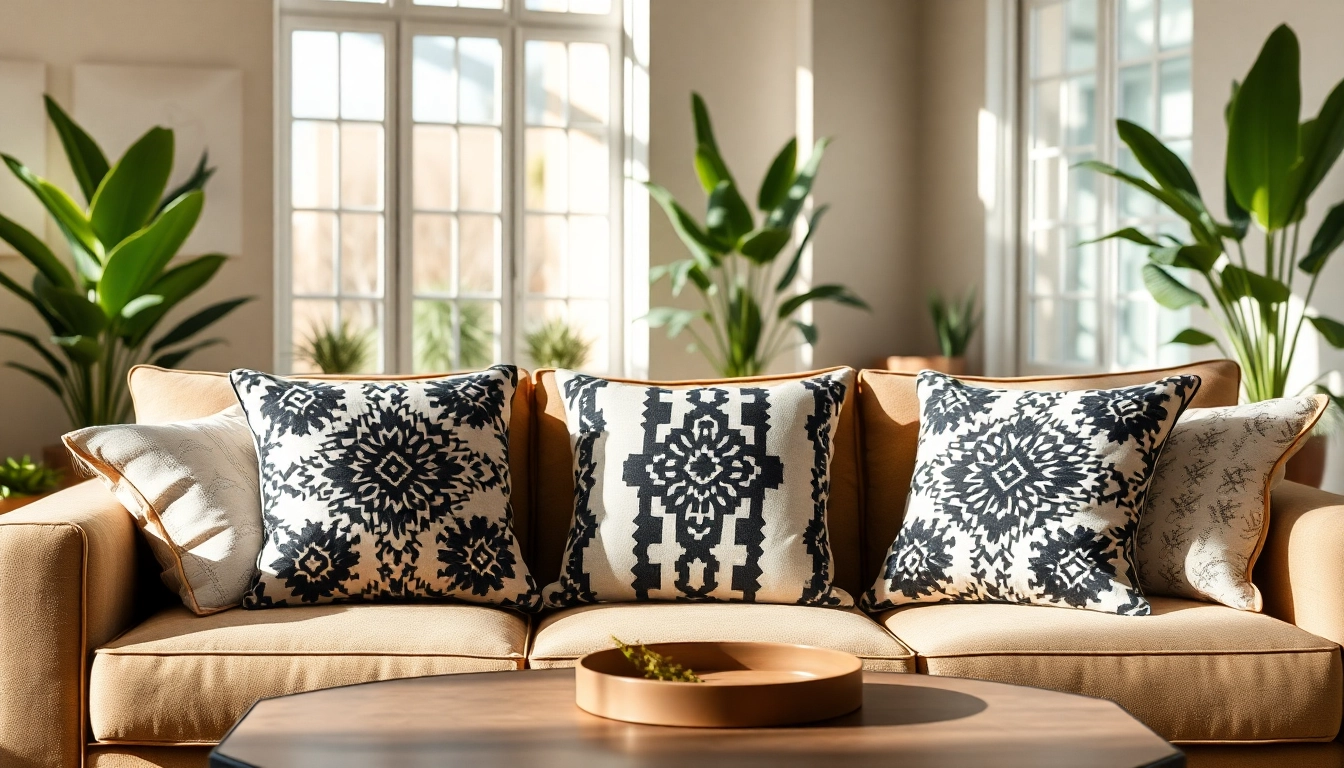Understanding Mali Mudcloth Cushion Covers
What Are Mali Mudcloth Cushion Covers?
Mali Mudcloth cushion covers are unique textile creations rooted in the rich cultural heritage of Mali, West Africa. Known locally as “Bògòlanfini,” these covers are made from handwoven cotton fabric, traditionally dyed with fermented mud and natural pigments. Each piece reflects a diverse history and is characterized by geometric patterns and symbols that often carry deep meanings, telling stories of the communities and artisans who create them. The vibrant designs not only serve as decorative elements for your home but also as a conversation starter that showcases your appreciation for cultural artistry. Mali Mudcloth Cushion Covers are therefore more than mere household items; they are a bridge between art and functionality.
Historical Significance of Mudcloth
The history of mudcloth is as rich and textured as the fabric itself. Originating in the 12th century, it is traditionally handmade by the Bamana people in Mali. The process involves weaving, dyeing, and decorating the fabric using ancient techniques that have been passed down through generations. Each symbol and pattern on the fabric may represent various things, from fertility to prosperity, showcasing the beliefs and values of the culture. Historical significance aside, the mudcloth’s resurgence in contemporary decor highlights a growing appreciation for sustainable and artisanal craftsmanship in home design.
Handmade Craftsmanship Behind Each Cushion
The allure of Mali Mudcloth cushion covers lies heavily within the meticulous craftsmanship involved in their creation. Artisans begin with raw cotton, which is intricately woven into fabric. The next step involves dyeing using natural resources such as tree bark and mud, lending the cloth its earthy tones. This handmade process not only strengthens the fabric but gives each piece its unique characteristics. No two cushions are identical, and as a result, your cushions carry a personal touch that mass-produced items cannot offer. The painstaking attention to detail and commitment to tradition ensure that every cushion is a work of art.
The Aesthetic Appeal of Mali Mudcloth Cushion Covers
Design Inspirations and Patterns
The distinct design of Mali Mudcloth is rooted in African symbolism, making it a perfect addition to modern and traditional styles alike. The geometric patterns range from simple stripes to intricate motifs, each telling its own story or reflecting various aspects of the culture. For example, a zig-zag pattern symbolizes the path of life, while dots may represent a concept of unity. These designs inspire creativity, allowing you to mix and match with other decorative elements in your home, creating a personalized style that is both sophisticated and culturally relevant.
Color Palettes That Complement Your Home
One of the remarkable features of Mali Mudcloth cushion covers is their ability to complement a variety of color palettes. Earthy tones dominate the fabric, typically featuring whites, browns, blacks, and natural hues, making them versatile enough to fit any interior design scheme. Whether you have a minimalist decor style or prefer eclectic aesthetics, the cushion covers can serve as a striking focal point. They can beautifully offset neutral tones or add warmth to cooler color schemes, allowing for easy integration into your living spaces.
Styling Tips for Living Spaces
When it comes to styling with Mali Mudcloth cushion covers, the possibilities are endless. Here are some tips to enhance your living spaces:
- Layer Textures: Combine mudcloth cushions with other textiles like linen or velvet to create depth and interest.
- Mix Patterns: Don’t shy away from mixing mudcloth with other patterns; the slight irregularities of handmade items can enhance rather than clash.
- Use a Statement Piece: Consider using a larger mudcloth pillow as the centerpiece on a sofa or bed, complemented by solid-colored cushions for balance.
- Accent with Nature: Add plants or natural wood elements to create an organic feel that enhances the cushions’ earthy vibe.
Benefits of Using Mali Mudcloth Cushion Covers
Durability and Quality of Materials
The durability of Mali Mudcloth is rooted in its handmade weaving process, which yields a strong and long-lasting product. The natural dyes used not only contribute to its understated beauty but also enhance the cushion covers’ resistance to fading, ensuring they maintain their vibrant appeal over time. Investing in high-quality mudcloth covers means you’re choosing durability—perfect for households with pets or children.
Versatility in Home Decor
Mali Mudcloth cushion covers embody versatility, allowing you to transition them seamlessly between various rooms and styles. From the living room to the bedroom, they can adapt to any decor theme—be it bohemian, minimalist, or rustic. Their unique appearance makes them ideal for layering, pairing well with different colors, textures, and patterns. This adaptability ensures they remain a stylish component of your home for years to come.
Eco-Friendly and Sustainable Choices
Choosing Mali Mudcloth cushion covers is not just a design choice; it’s also a step toward sustainable living. The traditional methods used in their production prioritize natural ingredients and minimize environmental impact. With a growing emphasis on eco-friendly home goods, these cushions appeal to consumers looking to make more responsible purchasing decisions. By displaying these beauties in your home, you send a message about supporting artisan craftsmanship and eco-conscious practices.
Care and Maintenance of Mali Mudcloth Cushion Covers
Washing Instructions for Longevity
To ensure your Mali Mudcloth cushion covers last long and retain their beauty, proper care is essential. Hand washing is recommended using cold water and mild detergent. Avoid bleach, as it can cause fading and damage the natural dyes. If machine washing is necessary, opt for the gentle cycle while placing the covers in a mesh bag to prevent damage. Always air dry your cushion covers away from direct sunlight to maintain their color integrity.
Tips for Stain Removal
Stains can occasionally occur, but prompt action can prevent permanent damage. For minor stains, gently blot the area with a clean cloth and cold water, avoiding vigorous scrubbing. For more stubborn stains, creating a paste with baking soda and a bit of water can serve as a natural solution. Apply it to the stained area, let it sit, and then gently wipe away with a clean damp cloth.
How to Maintain Colors and Textures
To preserve the colors and textures of your Mali Mudcloth cushion covers, it’s important to rotate them regularly, preventing uneven wear and fading. Make sure to keep them away from direct sunlight when not in use, as prolonged exposure can lead to discoloration. Periodically fluff the cushions to maintain their shape and texture, ensuring they always look vibrant and inviting.
Where to Buy Authentic Mali Mudcloth Cushion Covers
Identifying Authenticity and Craftsmanship
When searching for Mali Mudcloth cushion covers, authenticity matters. Genuine mudcloth products feature irregularities in patterns and colors due to their handmade nature. When purchasing, inquire about the artisans or the production methods to ensure you are getting a true reflection of Mali’s rich textile traditions. A reputable seller will be eager to share details about the origins of their products.
Recommended Retailers and Online Shops
There are numerous places to find authentic Mali Mudcloth cushion covers, from local artisan markets to online platforms. Websites specializing in ethnic and artisan decor, such as Lab Boho, provide a curated selection of high-quality products. It’s also worthwhile to check platforms like Etsy or directly support artisan collectives that specialize in African textiles.
Price Ranges and What to Expect
The price of Mali Mudcloth cushion covers can vary based on size, craftsmanship, and retailer. Generally, you can expect to spend anywhere from $30 to $150 per cushion. While investing in artisanal pieces may seem higher initially, the durability, unique character, and cultural storytelling inherent in each cover justify the cost. When shopping, consider the value of supporting traditional craftsmanship along with the unique decor they bring to your home.








